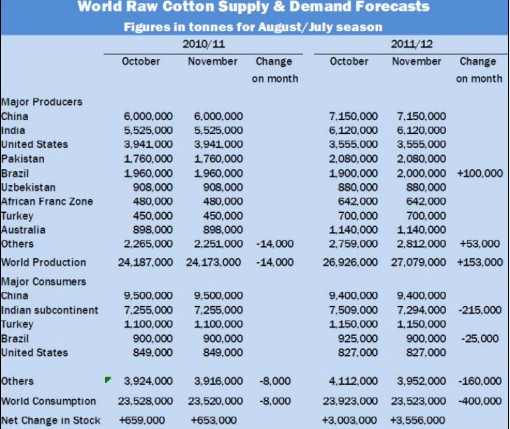|
LAHORE (September 17 2010): After mulling over the past couple of weeks trying to seek a direction, cotton futures in New York (ICE) reached sky high this week shattering the ninety cents per pound ceiling for the active December 2010 contract and is now possibly scheming to go beyond a dollar a pound territory. One leading news agency has postulated the cotton futures could even venture to vie for a dollar and 25 cents a pound in January, 2011. Bad weather in China where demand for cotton fiber remains forceful, yarn and fabrics prices expected to rise in tandem with cotton prices, sustained mills buying and covering on the global market, more demand than supply of cotton around the world due to output reductions in Pakistan, brazil and some African countries, a tight grip of hedge funds on cotton and other commodities and weakening of the United States dollar have lumped together to propel fiber pries to ethereal heights. The trouble with such state of affairs is that there is no knowing when commodity prices recede or retract to lop off their lofty gains and leave the investors in a lurch. The obvious result is that many spinners and weavers remain in a quandary as to when they should cover their cotton requirements. However, some markets are reporting that yarn prices are lagging behind the increase in cotton prices. Then there is the eternal problem of non-performance of contracts by some shippers either deliberately or under the formulation of some government law or prescription which delays or frustrates the pending contracts of cotton. It is too early to say if such fears will actively materialise on a large scale, but the specter of such of such probability continues to haunt the buyers. In Pakistan, cotton market appeared quiet on Thursday afternoon and lacked any perceptible bounce. But since beginning of this month lint prices have gained from Rs 400 to Rs 500 per maund (37.32 Kgs) in the ready market. Like wise, the ex-gin prices of grade three cotton have also been hiked by the Karachi Cotton Association (KCA) and fixed at Rs 6850 per maund on Thursday. Following the devastating floods and rains over the past six or seven weeks in Pakistan, crop output for the current season (August 2010-July 2011) has been revised downwards to range between 12 to 12.25 million domestic size bales on an ex-gin basis. Earlier cotton pundits had hoped that we would reap between 13.5 to 14 million bales of local size on an ex-gin basis. Pitted against these statistics, today's idea of domestic mills consumption ranges between 14.75 and 15 million bales. The ensuing shortfall will have to be imported. Such developments bespeak of an element of volatility which has infused a high dose of nervousness amongst the traders as well as the consumers. Upto now it is believed that Pakistan has booked about one million bales (170 Kgs) of cotton from sundry sources, part of which is on an "unfixed" basis, and about half of million of it is estimated to be from India. According to some sources, the prices of cotton have gone up by about fifteen cents a pound since Pakistani spinners booked their purchases from India. On Thursday, seedcotton (Kapas/Phutti) prices ranged between Rs 3050 to Rs 3100 per 40 Kgs in Sindh while in the Punjab they were said to have ranged from Rs 2950 to Rs 3050 per 40 kilogrammes. Generally speaking, lint prices in Sindh reportedly ranged from Rs 6850 to Rs 6900 per maund (37.32 Kgs), while in the Punjab they were said to have ranged between Rs 6700 to Rs 6850 per maund in a weakish market. In ready market, 1000 bales of cotton each from Shahdadpur, Sanghar and Nawabshah in Sindh sold at Rs 6800 per maund (37.32 Kgs), 1000 bales from Shahdadpur sold at Rs 6850 per maund, 400 bales each from Shahdadpur and Tando Adam sold at Rs 6900 per maund, while 200 bales from Tando Adam also sold at Rs 7000 per maund. In the Punjab, 700 bales of cotton from Bahawalnagar sold at Rs 6700 per maund, 400 bales from Hasilpur sold at Rs 6750 per maund, while 800 bales also from Bahawalnagar sold at Rs 6800 per maund. Since the beginning of this season (August 2010) seedcotton equivalent to about 1.6 million local size bales have arrived into the ginning factories from which the domestic mills are said to have lifted 1.4 million bales and the balance remain with the ginners. On the global economic and financial front, the concern about the pace of recovery remains serious as the sluggish pace of several leading economies like the United States, the Eurozone and elsewhere are keeping the investors jittery. At best, equity markets continue to post a mixed performance. The United States loan demand has dropped while housing and unemployment remain serious issues in America. Symptomatic of the global economic malaise is the four month high record rise in gold prices in the Unites States at Dollar 1270 an ounce on fears that the United States Federal Reserve Bank is going to further cut back growth forecasts and continue easing its leading operations in its bid to put the shaky global economy back on the track. Thus the overall confidence in an early global economic recovery remains dicey. |
|
Cotton prices hit the stratosphere
Updated: 2010-9-17 Source: business recorder

Recommended News
Photo Gallery
Most Popular



